 PO
Box 9021, Wilmington, DE 19809, USA
PO
Box 9021, Wilmington, DE 19809, USAE-mail: font@focusonnature.com
Phone: Toll-free in USA 1-888-721-3555
or 302/529-1876
 PO
Box 9021, Wilmington, DE 19809, USA
PO
Box 9021, Wilmington, DE 19809, USA
E-mail: font@focusonnature.com
Phone: Toll-free in USA 1-888-721-3555
or 302/529-1876
Solar
Eclipses
and
Other Celestial Nature
during Focus On Nature Tours
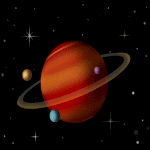
ECLIPSES DURING FONT TOURS:
Total Solar - Costa Rica, July 1991
Total
Solar - Bolivia, November 1994
Total Solar - Venezuela, February 1998
Total Solar - Turkey, August, 1999
Annular Solar - Iceland, May 2003
Total Lunar - Chile, November 2003
Partial Solar - Guatemala, April 2005
Annular Solar - Spain, October 2005
Total Solar - Japan, July
2009
Also observed during FONT Tours:
 Aurora Borealis
- Iceland, annually in October
Aurora Borealis
- Iceland, annually in October
Upcoming Iceland Tour Itinerary
The "Green Flash" - in the Caribbean,
southern Argentina & Japan
Comets - in 1996 & 1997, notably during tours
in the Caribbean & in Spain
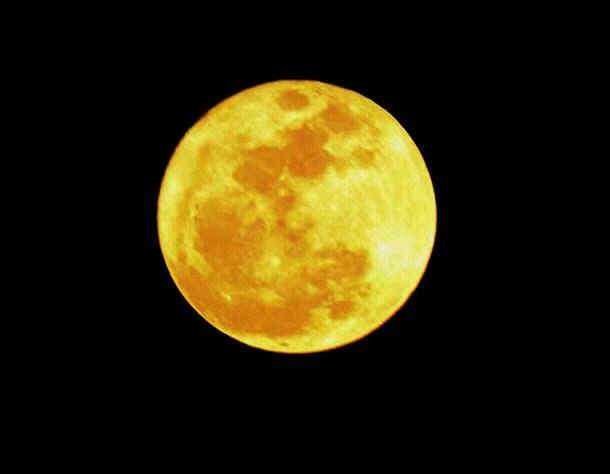
On March 19, 2011, the Full
Moon.
Known either as a "Super Moon", or more scientifically "Perigee-Syzygy",
about as close as a Full Moon can be to the Earth.
The moon in this photo, 221,565 miles away.
The distance between Earth & Moon varies,
due to the elliptical orbit of the Moon,
from about 222,000 to 252,000 miles.
When at Perigee-Syzygy, the Full Moon is about 14% larger
and 30% brighter than a moon at its furthest distance from the Earth.
(photo by Marie Gardner)
There's more about the ""Super Moon"" reached from the
link above.
![]()

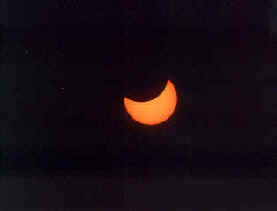
The following was written by Armas Hill,
who has led all of the FONT tours during which there have been solar eclipses, and
lunar eclipses, and comets and meteor showers
in the night-time sky, and "Northern Lights" or Aurora Borealis (known as
"Norourljos" in Icelandic), and the phenomenon at sunset known as the
"Green Flash" in the Caribbean, on the vast Patagonian expanse
of southern Argentina, and over the Sea of Japan.
There was another interesting celestial occurrence in 2004, when during the last night of a Panama tour, the 5 planets
closest to Earth, were lined up in the western evening sky just after sunset:
Mercury, Venus, Mars, Jupiter, and Saturn. That line-up was seen from atop a hotel
in Panama City as the Panamanian race of the Common Nighthawk was
flying about and calling nearby, thus providing a backdrop for the rare celestial
event.
* * * * * * * * * * * *
ECLIPSES
(SOLAR & LUNAR):
Since
1991, there have been 8 FONT birding & nature tours during which there have
been SOLAR ECLIPSES (5 of them TOTAL, 2 of them ANNULAR, and 1 PARTIAL).
Along with narratives, photographs follow that were taken during those
tours.
First, however:
SOME INTERESTING BACKGROUND INFO REGARDING ECLIPSES
"Among all the wonders of science, the most gorgeous spectacle is exhibited
by the queen of sciences, astronomy, at the moment when the Earth is shrouded in
darkness and when around the smiling orb of day there appears the matchless
crown of the corona. Nor can any science duplicate the precision shown by the
work of the astronomer in his or her capacity to predict hundreds of years in
advance the exact hour and minute at which an eclipse will take place and the
locality where such an eclipse will be visible."
The above commentary is from the 1923 edition of "Eclipses of the
Sun", by S. A. Mitchell.
There are different types of eclipses:
Those who have had the good fortune to see a TOTAL SOLAR ECLIPSE have called it
the most beautiful and dramatic of celestial events.
ANNUAL (or "Ring of Fire") SOLAR ECLIPSES have also attracted wide
attention. Some eclipses (rarely) are a combination ANNULAR/TOTAL. Others are
neither, being only PARTIAL. Total and Annular Eclipses away from the central
zone are also PARTIAL.
And there are also the more common LUNAR ECLIPSES, which have taken "a
backseat" to solar eclipses, but which bring with them a unique
beauty.
One of the first to understand eclipses (even though only partially) was the 1st
Century B.C. Chinese astronomer, Liu Hsiang. He wrote that the Sun is eclipsed
because "the Moon hides him as she moves on her way."
A SOLAR ECLIPSE is the result of the Moon coming between the Earth and the Sun.
A LUNAR ECLIPSE is the result of the Earth coming between the Sun and the Moon.
That's all rather simple, but as to why eclipses only happen at certain times is
a bit more complicated.
Solar eclipses, as implied above, are due to the Moon's shadow on the Earth.
There are 2 parts of the Moon's shadow, as there are with all shadows. There's a
central, cone-shaped portion called the UMBRA. There's a fan-shaped area called
the PENUMBRA. For those outside the penumbra, there's no eclipse. For those
positioned within the penumbra, there's a partial eclipse of the Sun. The
further that one is within the penumbra, the greater the percentage of the Sun
covered by the Moon. Those situated within the umbra will see a total solar
eclipse. Since both the Earth and the Moon are moving, the umbra will trace a
line along the Earth's surface during an eclipse, creating a CENTRAL PATH OF
TOTALITY. The region of the Earth with a PARTIAL SOLAR ECLIPSE is usually
bow-shaped due to the Earth's curvature in relation to the movements of the Moon
and Earth.
The Moon orbits the Earth once every 27.3 days (a SIDEREAL MONTH). The Earth
orbits the Sun in 365.2 days. From these combined motions, it has been found
that the Moon takes 29.5 days (about 2 days longer than a sidereal month) to go
through a complete set of PHASES: New Moon, then on to First Quarter, Full Moon,
Last Quarter, and back to New again. This period (of 29.5 days) is called a
SYNODIC MONTH.
The explanation as to why eclipses don't occur every month begins with the fact
that the Moon's orbit around the Earth is inclined by about 5 degrees with
respect to the Earth's orbit of the Sun. As a result, the Moon crosses the
Earth's orbital plane (the ECLIPTIC) twice every orbit, at points called NODES.
The Moon is usually above or below the Sun in our sky at NEW MOON. It misses the
Earth's shadow at FULL. Only on the comparatively rare occasions when the Moon
passes near a NODE at the NEW and FULL PHASES can an eclipse take place. The
nodes gradually shift location along the ecliptic as the Sun and Earth play kind
of a "celestial tug-of-war" called REGRESSION OF THE NODES, with the
Moon caught in the middle. This drifting of the nodes realigns the NEW MOON and
FULL MOON PHASES with the Sun every 173.3 days, a period referred to as an
ECLIPSE SEASON. Therefore, in each calendar year, there are at least 2 eclipse
seasons when solar and lunar eclipses can occur. 2 eclipse seasons make up an
ECLIPSE YEAR, or 346.6 days.
Thus, an ECLIPSE YEAR is shorter than a CALENDAR YEAR by 18.6 days. This
difference gives some calendar years not 2, but 3, 4, or even 5 solar eclipses!
There may also be up to 5 lunar eclipses. But the combined number of lunar and
solar eclipses will never exceed 7.
7-eclipse years are rare. The last such year, 1982, featured 3 total lunar and 4
partial solar eclipses. The next such year, 2038, will bring with it 4 penumbral
(or partial) lunar, one total solar, and 2 annual solar eclipses.
Typically, eclipses occur in pairs, with a solar eclipse preceding and/or
following (by about 15 days) a lunar eclipse.
Let's go back again to the Moon's shadow referred to earlier as the UMBRA. When
that shadow reaches the Earth, it is 170 miles (270 kilometers) across at its
widest. It can travel a third of the way around the Earth in a matter of a few
hours.
The Sun measures 864,900 miles (1,392,000 kilometers) in diameter. In
comparison, the Moon is a relatively puny 2,160 miles (3,476 kilometers) across.
That's a ratio of approximately 400 to 1 - that is, the Sun is about 400 times
larger in diameter than the Moon.
The Sun is about 93,000,000 miles (149,600,000 kilometers) from the Earth.
Comparatively, the Moon is "right next door" at 240,000 miles (384,500
kilometers) away. That ratio, coincidentally, is also 400 to 1.
So (as a quirk), the Moon and Sun each appear about the same size in our sky -
by about half a degree.
This "near-perfect fit" of the Moon just covering the Sun's blindingly
bright surface (or PHOTOSPHERE) enables aspects of the star to be seen that
normally would not be. Surrounding the photosphere is a thin, deep-red layer of
the Sun called the CHROMOSPHERE. Measuring only a few thousand kilometers thick,
the chromosphere can usually be seen only scant seconds at the beginning and end
of totality. Protruding from behind the Moon's silhouette are the glorious,
flame-like PROMINENCES, stretching for thousands of kilometers into space.
Encircling the eclipsed Sun and extending for several times the Sun's diameter,
is the pearly white CORONA.
Incidentally, the appearances of both the prominences and corona vary by
eclipse.
Were it not for the "near-perfect fit" of the Moon and the Sun, the
solar features just described would not be visible. If the Moon appeared
noticeably larger than the Sun in our sky, of course they would be blocked from
view. If the Moon were to be apparently smaller, then the bright surface of the
Sun would never be fully covered, leaving them lost in the glare.
Of all the planets and satellites in our Solar System, it is only on Earth where
such a circumstance occurs enabling the Sun and its related components to be
viewed. On all of the other planets, their satellites are either too small or
too large to cover the Sun so perfectly.
The Moon's orbit around the Earth is not circular. It is, rather, oval or
elliptical. At its closest point (called PERIGEE), the Moon is 221,000 miles
(356,000 kilometers) away, while at its farthest (APOGEE), the Moon is 253.000
miles (407,000 kilometers) distant.
Likewise, the Earth's orbit of the Sun is elliptical, bringing it as close as
91,452,000 miles (147,100,000 kilometers) at PERIHELION (the point where the
Earth is closest to the Sun), and as far as 94,562,000 miles (152,102,000
kilometers) at APHELION (the point where the Earth is farthest from the Sun.)
As a result, the apparent sizes of the Moon and Sun in our sky vary
slightly.
The greater the Moon-to-Sun size ratio, the longer an eclipse's duration. At its
longest, totality can last 7 minutes, 31 seconds, but eclipses that long are
exceedingly rare. Totality during the solar eclipse of June 25, 2150 will last 7
minutes, 14 seconds, longer than any total solar eclipse since the 9th Century
A.D. Usually the period of totality is shorter than 5 minutes.
When the Moon appears smaller than the Sun as it passes centrally across the
solar disk, there's a bright ring, or ANNULUS, of sunlight that's visible at the
time of greatest eclipse. This occurrence is an ANNULAR ECLIPSE. During the
event, as the bright photosphere is never fully covered by the Moon, the
chromosphere, corona, and prominences usually remain hidden from view. Instead,
there's what might be described as a sort of "celestial doughnut" or a
"ring of fire". Although not thought of as being as magnificent as
total eclipses, ANNULARS are still quite spectacular in their own right. The
"ring of fire" during such eclipses glows brighter than the corona of
total eclipses.
Earlier mention was made of the PENUMBRA, one of two
types of lunar shadow. When only the lunar penumbra touches the Earth, as the
umbra is cast off into space missing our world entirely. That circumstance
causes a PARTIAL SOLAR ECLIPSE. As with all solar eclipses, the percentage of
the Sun eclipsed varies dependent upon the observer's location, but in this case
the Sun is ONLY eclipsed partially.
During any PARTIAL SOLAR ECLIPSE (either as a part of a total or annular eclipse
or not), a criteria for indicating how much of the Sun's diameter is covered by
the Moon is termed MAGNITUDE. Values less than 1 are given in relation to the
percentage covered. How much of the Sun is hidden by the Moon depends on both
the nature of the eclipse, and the observer's location within the eclipsed
region.
To clarify this concept of MAGNITUDE, in a 0.5-magnitude solar eclipse, 50 per
cent of the Sun's DIAMETER is obscured. When that occurs (that is the Moon
covers half of the Sun's diameter), 40 per cent of the Sun's area is blocked. In
a 0.3-magnitude eclipse, 19 per cent is obscured; in a 0.7-magnitude eclipse, 63
per cent.
LUNAR ECLIPSES, which occur whenever the Moon passes through the Earth's
shadow, only happen when the MOON is FULL.
While a solar eclipse is seen over only a small portion of the day side of the
Earth, and varies as to the location of the observer in relative to the point of
maximum eclipse, a LUNAR ECLIPSE can be viewed from across the entire night side
of the Earth (weather permitting, of course), and appears the SAME to all
observers in the Earth's night hemisphere.
There are 3 types of LUNAR ECLIPSES:
A TOTAL LUNAR ECLIPSE occurs when the Moon's entire disk is bathed in the
Earth's umbra. The Moon never completely disappears during a total lunar
eclipse. Even at maximum, a small amount of sunlight is bent, or refracted,
through our atmosphere and into the Earth's shadow. Due to the refractive
properties of the atmosphere, light from the blue end of the visible spectrum is
scattered, while light from the red end is more readily passed (pardon the pun).
Anyway, the result is a reddish cast to the Earth's shadow.
A PARTIAL LUNAR ECLIPSE occurs when the Moon is oriented so that only a portion
of it dips into the Earth's umbra.
A PENUMBRAL LUNAR ECLIPSE occurs when the Moon only passes through the faint
penumbral portion of the Earth's shadow.
No two lunar eclipses appear exactly the same. Sometimes the umbra appears a
bright red-orange; at other times it appears a dark coppery red or even a
brownish gray. A total lunar eclipse's color is dependent upon the clarity of
the Earth's upper atmosphere.
Just as a solar eclipse is referred to by its magnitude (that is, how much of
the solar disk is eclipsed), a lunar eclipse also has a magnitude values: the
PENUMBRAL MAGNITUDE and the UMBRAL MAGNITUDE.
The PENUMBRAL MAGNITUDE refers to how much of the Moon's DIAMETER is within the
Earth's penumbral shadow.
The UMBRAL MAGNITUDE is a measure of how deeply immersed the Moon is in the
Earth's umbra at maximum.
These magnitude designations do not refer to apparent brightness.
ECLIPSES DURING FONT TOURS:
1) TOTAL SOLAR ECLIPSE: JULY 1991
Our first total solar eclipse during a FONT tour was in northwestern Costa
Rica on
July 11, 1991.
Totality during that eclipse lasted nearly 7 minutes (6 min. 54 sec.).
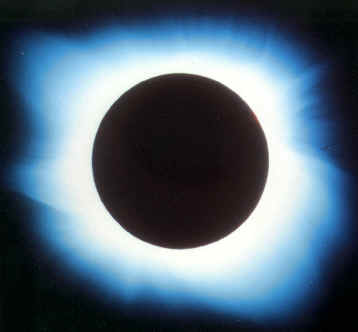
Photograph of the July
1991 Total Solar Eclipse, taken during a FONT birding tour in Costa Rica.
The
duration of totality was 6 minutes and 54 seconds.
This was the first of 5 total solar eclipses
that have been seen during FONT birding & nature tours.
2) TOTAL
SOLAR ECLIPSE: NOVEMBER 1994
On November 3, 1994,
we observed our second total solar eclipse when we were at an elevation of about
10,000 feet above sea level, high in the mountains of southern Bolivia.
It was as a special portion of our birding tour throughout Argentina. We crossed
the northernmost border of Argentina to spend the night prior to the eclipse in
a southern Bolivian village. The total eclipse was during a sharp clear sky
early the next morning. Photographs follow of some of the native people who
lived by the site where we observed the eclipse. With us there, were observers
from nearly 30 countries around the world, witnessing the eclipse during which
totality was 4 minutes and 24
seconds.

Photographs
(above
& below) of
the November 1994 Total Solar Eclipse,
taken during a FONT birding tour in
Bolivia.
The duration of totality was 4 minutes and 24 seconds.
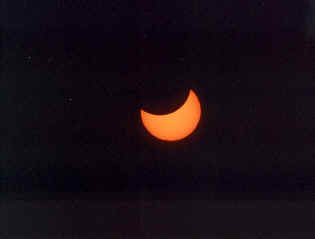
This eclipse was
observed in the Andes of southern Bolivia,at nearly 10,000 feet above sea-level.
Photos below are of local people at the observation site.

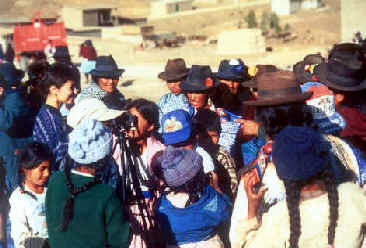
Local people in Bolivia,
where our group observed a total solar eclipse,
during a FONT birding tour
mostly in Argentina, November 1994.


3) TOTAL SOLAR ECLIPSE: FEBRUARY 1998
Our third total solar eclipse was seen from an Venezuelan island,
along the northern coast of that country on February
26, 1998. During an wonderfully clear
afternoon, the eclipse was during a birding tour when we traveled throughout Venezuela,
and as far west as the Colombian border. During this eclipse, totality lasted 4
minutes and 9 seconds.

Photograph of the February 26, 1998 Total
Solar Eclipse,
taken during a FONT birding & nature tour in Venezuela.
The duration
of totality was 4 minutes and 9 seconds.
Following this eclipse, there would not be
another total eclipse of the sun in the Western Hemisphere
(aside from a small part of Canadian Arctic),
until the year 2017.
4) TOTAL SOLAR ECLIPSE: AUGUST 1999
We observed our fourth total solar eclipse from a hilltop in central Turkey
on August 11, 1999.
During that tour we birded as far east in northern Turkey, along the coast of
the Black Sea, as the Caucasian Mountains. Again, as during our 3 previous
eclipses, the sky was perfectly clear (how lucky!). Totality during this eclipse
lasted 2 minutes and 23 seconds. This was the last eclipse of the millennium of
the 1900s.
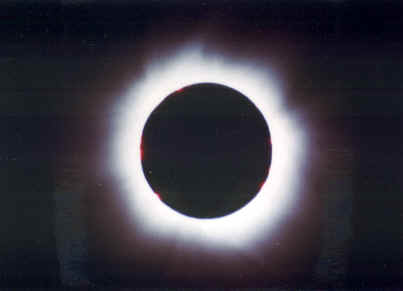
Photograph of the August
11, 1999 Total Solar Eclipse,
taken during a FONT birding & nature tour in Turkey.
The
duration of totality was 2 minutes and 23 seconds.
(Photo from a hillside near Kastamonu, Turkey.)
This was the 4th total
eclipse of the sun, during FONT birding tours.
Previous ones were in Costa Rica,
Bolivia, & Venezuela.
5) ANNULAR SOLAR ECLIPSE: MAY 2003
Our fifth solar eclipse during a FONT tour was a bit different in that it was an
Annular Solar Eclipse rather than Total.
It occurred during our 9th birding tour in Iceland,
early in the morning, on May 31, 2003.
We were in the town of Stykkisholmur, where during our previous tours in the
month of October, we observed "Northern Lights" or the Aurora Borealis
in the night sky. In late May in Iceland, there's really was no dark night sky. A few
hours before the eclipse, we were looking at a "Midnight Sun", an orange
ball, above the northern horizon.
Very early the morning of May 31, where the Sun was in the
northern Icelandic sky, there were no clouds. And thus we could see the ring of light of an Annular Solar Eclipse
that was unusual in a few ways.
Firstly, it was one for the 21st Century record books, since its path was
unusually broad. Due to the oblique angle of the Moon's shadow to the Earth, the
width of the eclipse's path was as wide as 3,000 miles. That's broader than any
other eclipse during the century just underway. But due to the remote location,
and the low altitude in the sky, relatively few people in the world were to
witness the event.
An Annular Solar Eclipse occurs when the Moon appears smaller than the Sun,
leaving a circle, or "annulus" of sunlight, a "ring of
fire", even when the eclipse is at maximum.
In Iceland, the eclipse was only 3 degrees above the horizon at maximum, and it
lasted 3 and a half minutes.
Another aspect of the May 31, '03 solar eclipse was unusual. Because the Moon's
shadow passed over the North Pole before it struck the Earth's surface, the path
of the eclipse actually ran in reverse of the norm - that is from east to
west!
Notes: The only total solar eclipse in 2003 was in Antarctica.
There were no total
solar eclipses anywhere on Earth in 2004.
6) TOTAL LUNAR ECLIPSE: NOVEMBER 2003
This eclipse occurred in Europe, northwestern Africa, eastern North America, and
in South America. We saw it the first night of our '03 Chile tour, November 8/9,
in Santiago, in a clear sky over the city. Where this eclipse was total, that
phase was short, lasting less than half an hour. The umbral magnitude was 1.02. The lunar disk
remained relatively bright.
7) ANNULAR/TOTAL SOLAR ECLIPSE: APRIL 2005
An eclipse on April 8, 2005 was an example of the
rarest type of solar eclipse: an annular/total eclipse.
Normally the Moon appears slightly larger than the Sun (creating a total solar
eclipse), or slightly smaller (producing an annular eclipse). But at those rare
times when the Sun and Moon appear very nearly the exact same size, then an
ANNULAR ECLIPSE occurs at each end of the eclipse path, as a TOTAL
ECLIPSE occurs at about the center of the path.
At the time of the eclipse, we were in Central America with a tour at the Mayan
ruins of Tikal in Guatemala. Although we were away from the narrow path of
annularity (only in a limited portion of Panama), it was quite interesting for
us that afternoon to observe a slight but apparent darkening of the sky, with
its affect notably on birds, as we were in the forest and by temples where a
civilization studied astronomy centuries ago.
8) ANNULAR SOLAR ECLIPSE: OCTOBER 2005
We witnessed the October 3, 2005 Annular Solar Eclipse
in an absolutely clear sky over Spain during the last day of a week-plus birding
& nature tour throughout the country, that ranged from the mountains to the
coast.
In Madrid, we saw nicely the form of the Moon, smaller than the Sun as it passed in
front of it, creating a "rim of fire" that lasted for 4 minutes & 11
seconds. That time of maximum eclipse was just before 11 o'clock in the morning.
It was, during the entire eclipse, an excellent show, with a clear sky from the
beginning to the end. Never, in fact, that day, in Madrid was there ever a cloud
in the clear and unhazy sky.
The eclipse's 3 and 1/2 hour path that was initially in Portugal and Spain later
traversed across mostly deserted parts of Africa: Algeria, Tunisia, Libya, Chad,
Sudan, Ethiopia, Kenya, and Somalia.
This was the first annular eclipse in the Iberian peninsula since April 1, 1764.
The next one there will be in 2028.
9) TOTAL SOLAR ECLIPSE: JULY 2009
At the north end of the southern Japanese island of Amami, we experienced a
total eclipse of the Sun on July 22, 2009. Our vantage point was at the
tip of a cape by the Pacific Ocean. During the eclipse, some of the people in
our group took a dip in the nearby ocean water, as overhead the disk of the Sun
could be seen shrinking and the sky's light was fading.
The Sun, at the totality of the eclipse, was high in the sky. The nearly 4
minutes of totality, where we were, was at about 11:00am.
Unfortunately, also in the sky above us were clouds. There was a thin layer of
them during most of the eclipse prior to totality, as well as during the nearly
4 minutes when darkness fell.
So, even though we could not see some of the features of a total eclipse that we
would have if the sky were cloudless, there certainly was an experience to be
had.
To the north of us, where totality was longer, we learned later that the clouds
were thicker (so thick that the eclipse overhead in the sky could not be seen at
all).
Along the center line, to our north, totality was about 2 minutes
longer, making it just over 6 minutes, and giving this eclipse the longest
period of totality of any during the entire 21st Century.
During the nearly 4 minutes of darkness where we were, there was a fascinating
pattern of clouds in our sky. Truly ominous they appeared. A short distance
away, during the mid-day darkness, the beacon of a lighthouse on rocks above the
sea shone as it would at night.
The Pacific Swallows, by the Pacific Ocean,
during dark totality stopped flying. They actively flew about us during most of
the eclipse. A Pacific Reef Heron flew along the water's edge of the Pacific,
also during the eclipse, as did some Roseate Terns.
Overall, birds that day at that cape at the north end of Amami Island were not
plentiful, but people were. Nicely, though, it was not crowded where we were, at our
good vantage point, but as we looked about, especially behind us, we could see that
we were but a few of the many who had come to experience the event. Mostly,
those who came were Japanese.
It was the first total solar eclipse in Japan in many (46) years, and so considerable
publicity and anticipation preceded it. From the heavily populated Japanese
islands to the north, many came to the relatively small, and usually not often
visited, Amami Island, coming over a period of days by plane or by ferry. (We did
the latter, from Okinawa.)
They filled the few hotels on Amami, but many who came for the eclipse camped in
tents at the north end of the island. We spent our nights in Amami in hotels (2
of them), but when we looked to our right, from our vantage point, we saw many
of the tents in the dark shadow of the eclipse. Turning to our left, we saw the
open water of the Pacific Ocean, while overhead there was, that morning, the
sun, the moon in front of it, and the clouds.
During our minutes of totality, to the south there was a brighter sky toward the
horizon, where a few miles away, in that direction, the shadow of totality did not
occur.
Just about 2 hours after the eclipse, as we were going south from the totality
zone toward town (to Naze, the largest city, and actually the only city on Amami),
rain poured down from the clouds that by then had thickened. Earlier that day,
by comparison, we had been fortunate to have had the eclipse experience that we
did - the 8th solar eclipse during a FONT tour, and the 5th for us, since 1991,
with
totality.
![]()
2 excellent books regarding Eclipses of the Sun are:
"Totality - Eclipses of the Sun", by Mark Littmann & Ken Willcox,
1991
"Eclipse! - the What, Where, When, Why & How Guide to Watching Solar
& Lunar Eclipse", by Philip S. Harrington, 1997
During FONT birding & nature tours throughout the world, in the 1990's,
there were a couple notable Comets in the night-time sky:
COMET HYAKUTAKE was a small comet that reached first magnitude as it came within
16 million kilometers of Earth in late March 1996. It glided across the sky from
the constellations of Bootes to Polaris (the North Star) in less than a week,
having a thin blue tail that reached a length of 65 degrees. It would have
remained the brightest comet of two decades had not the even brighter Comet
Hale-Bopp (referred to below) arrived a year later.
Comet Hyakutake was in the night-time sky during FONT Caribbean tours in March
1996. A memory from Jamaica is of an Antillean
Nighthawk flying and calling in the sky, as the comet was above.
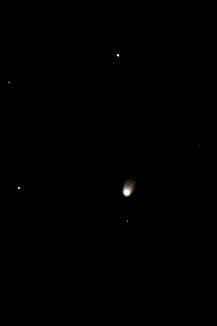
The bright object in this
night-time sky
was the Hale-Bopp Comet
in the spring of 1997.
(photo by Doris Potter)
COMET HALE-BOPP
was first-magnitude or brighter throughout most of March &
April 1997. It was bright enough to be an attention-grabber in moonlight. Hale-Bopp
holds the all-time record as being the only comet in history visible to the
naked eye for more than a full year.
Comet Hale-Bopp
was the brightest comet visible in the evening sky in the
Northern Hemisphere since Halley's Comet in 1910. It was the biggest comet to
visit the inner Solar System in more than 200 years. The comet's 35-kilometer
diameter icy nucleus was at least 10 times more massive than the nucleus of
Halley's Comet, making it one of the largest-known comets. Comet
Hyakutake, of
the previous year, passed 13 times closer to Earth than
Hale-Bopp,
but it was
less than 1 percent the size.
Comet Hale-Bopp
sported two tails. The almost featureless white tail was dust
illuminated by sunlight. The blue tail was gas excited to luminescence by solar
wind. Comet Hyakutake (in March 1996) had a longer tail than
Hale-Bopp,
but it
was less conspicuous overall (as already noted, due to its smaller size).
Comet Hale-Bopp's
nucleus was shedding up to 100 tons of gas and vapor per
second when it was at its brightest. Even so, less than one-hundreth of 1 per
cent of the mass of the comet's nucleus was vaporized during its trip through
the inner Solar System.
The swept-back tails of comets make them appear as if they are moving headfirst,
tail last. But the comet's motion has little to do with the tail's streamlined
looks. Since solar radiation pushes back the tail, comets always point toward
the Sun. As they follow their elongated orbits around the Sun, comets come in
headfirst and leave tail first.
Comet Hale-Bopp's
orbit is huge. The comet's last pass through our sector of the
Solar System occurred 4,206 years ago. Due to a swing within 120 million
kilometers of the large planet Jupiter in July 1996, the comet's orbit was
reshaped (by the planet's gravitational influence), and so the comet will now
return sooner to the inner Solar System - in 2,380 years!
Comet Hale-Bopp was in the night-time during a number of FONT tours in 1997,
but notably in clear non-light-polluted skies above the Caribbean, and the
desert of southern Spain.

Comets are among the celestial
phenomena in these photographs
that were taken during our FONT tour in 2010
at the Kitts Peak Observatory in southern Arizona.
The observatory is on a mountaintop surrounded
by the land of the Tohano O'odam Indians.
When we visit this area, that's good for birding,
during our Arizona tours, those who wish
can visit this most interesting astronomical facility.
(photos by Rise Hill)
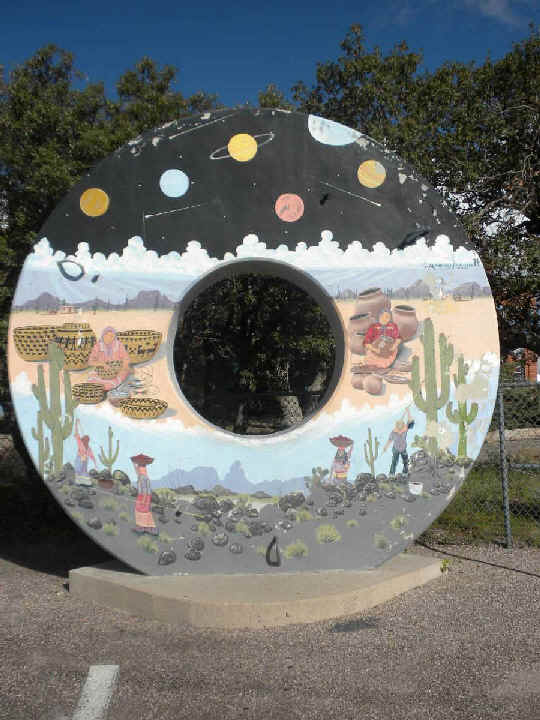
![]()
the
Aurora Borealis
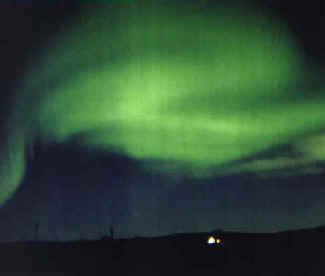
The Aurora Borealis,
or Northern Lights,
as seen during FONT Iceland tours during October.
During October nights in Iceland,
during all of our tours there that month (and during late September too), we've watched "Northern Lights"
dance in the sky. First as a blue-white veil, later green. First around 8pm or
9pm,
then around midnight, we've seen some quite spectacular displays. Often there was
a myriad of stars as a backdrop behind the auroral show that was above us.
The Aurora Borealis, or "Northern Lights", as they occur in and near
the Arctic, are truly among the most spectacular of natural phenomena on Earth.
With it, there's beauty and splendor. The polar explorer, William Hooper, said
of the Aurora Borealis: "Language is vain in the attempt to describe its
ever varying and gorgeous phases; no pen or pencil can portray its fickle hues,
its radiance, and its grandeur."
Early descriptions of the aurora, as well as words could give, are contained in
the mythology of the Eskimos, the Lapps, and Medieval Europeans. Even in the Old
Testament. But it has not been until recently that the phenomena has been more
fully understood. It's now known that auroral lights appear when atoms and
molecules in the upper atmosphere are hit by high speed electrons, or charged
particles. These particles rain in space. When they impinge upon the Earth's
upper atmosphere and radiation belts, the aurora materializes. The particles
striking atoms and molecules excite them. Radiation from the ions and atoms
causes the emission of light, which can be blue, green, white, or red. The most
spectacular auroras occur at elevations of 50 to 100 miles above the Earth's
surface. Auroras can occur, however, as high as 600 miles above us.
The electrical power associated with auroral discharge can be enormous, about
1,000 billion watts, or an annual 9,000 billion kilowatt-hours. That's much more
than the present annual consumption of electric power in the U.S. (which is
approximately 1,000 kilowatt-hours).
A typical display of the Aurora Borealis begins as a glow on the horizon, rising
gradually to become an arc.
(We've seen numerous such displays in Iceland, but recalling one in particular,
during the night of October 11, 1999, that's how it began. The bottom of the arc
then brightened and streamers went forth. Then the arc lost regularity and
developed "folds" in the manner of a shiny, waving curtain. This
spectacular phenomenon can last for hours during long arctic nights. For us,
during the night of October 11-12, the aurora was still going strong after
midnight until the sky turned
cloudy.)
![]()
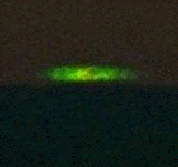
During our
March Lesser Antilles Tours, we've seen something interesting - not a bird, or
animal, or something else on the ground or in the sea. Rather, it was something
in the sky.
From the islands of Saint Lucia, Saint Vincent, and Dominica, looking out to
sea, in the western sky, at sunset, we've seen what's known as the "green
flash". It was visible just as the red ball of the sun dipped
below the horizon, appearing rather like a bright spark from an electric wire.
Some consider it to be fantasy, but, really, given the right circumstances, it
can be seen.
The following is an astute account of it, taken from the book "Eastward to Singapore", written by a surviving officer of a vessel named the "Electra". The "Electra" disappeared in World War II in the battle of the Java Sea in February 1942:
"In the region of the equator, the
sun sets with a jerk, and legend has it that at sunset, a "green
flash" spreads across the horizon. On the "Electra", opinion was
divided as to whether or not this was merely a fairy tale. So, as the ship was
due to cross the line at almost precisely sunset, the bridge became packed with
officers inquisitive and eager to resolve the argument.
Yet, as the sun went down, the triumphant shout of the believers, all of whom
swore they'd seen the flash "as fast as lightning", was followed by
derisive jeers from the infidels who said they hadn't.
So in the end, the test was a disappointment except that it proved that people
will only see as much or as little as they have a mind to believe in".
A long time ago (relatively), in January
1960, in the magazine "Scientific American" there was an excellent
article, with some tremendous photographs, entitled "The Green Flash and
Other Low Sun Phenomena".
Now, on the internet, there's more info about the "green
flash".
| Flash - Wikipedia |
Focus On Nature Tours will be going to
the Caribbean again in 2012.
The itineraries for the tours, and other information, is in the web-site (if
you're interested in seeing the "green flash" for yourself, along with
the parrots and other birds of the Caribbean).
Upcoming FONT Caribbean Birding Tours
![]()
In the photograph below is the full moon on March
19, 2011, as it was rising over the Atlantic Ocean
just beyond the Barnegat Lighthouse, in New Jersey, USA.
That full moon that night was of rare size and beauty,
as it was the largest full moon in nearly 20 years.
Called by some the "Super Moon", but more properly
a phenomenon said by astronomers to be ""Perigee-Syzygy",
this full moon was about 12% larger than an average moon.
Such a moon is about 14% larger and 30% brighter
than a full moon at its furthest from Earth.
The variation of the distance between Earth and Moon
is approximately from 222,000 to 252,000 miles,
due to the elliptical orbit of the Moon around the Earth.
The March 2011 full moon was 221,565 miles from Earth,
and it will be many years until a full moon will again be as
close.
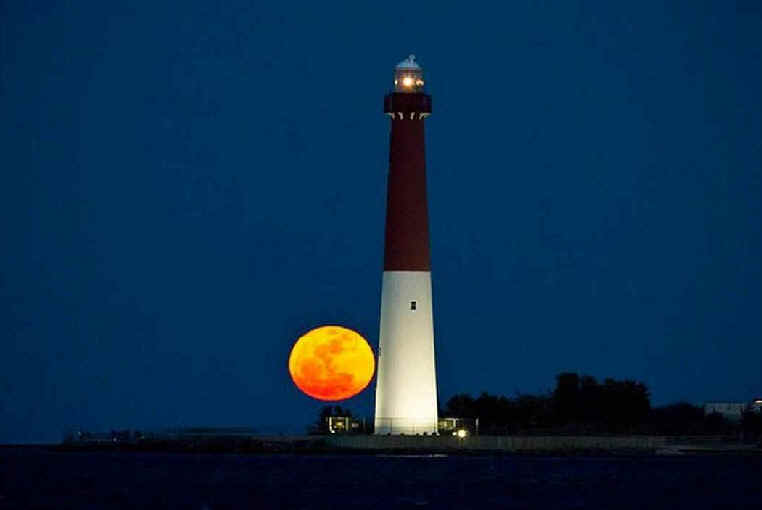
The "Super Moon" rising at Barnegat Lighthouse, New Jersey on March
19, 2011